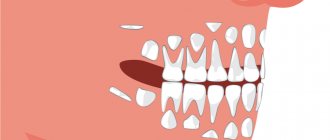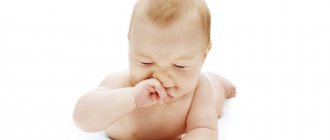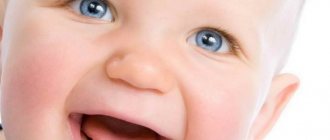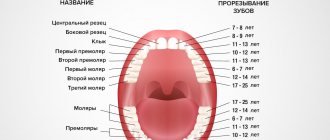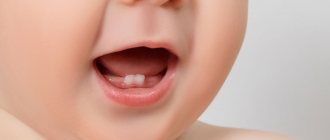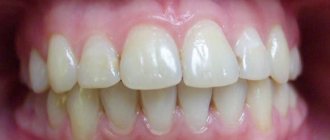How many teeth should a child have?
By the age of three, a child usually already has a full set of twenty primary teeth, and until about 6 years old, their number remains unchanged. Adolescents aged 13 to 18 years should normally have from 28 to 32 molars (depending on the presence of eights, which may erupt after 21 years or not appear at all).
Changing baby teeth to molars
Around the age of 4, a child’s growth spurt begins, the jaws enlarge and the baby teeth seem to move apart, with gaps appearing between them – trema. If this does not happen and by the age of 5 the teeth are still tight, you need to show the child to the dentist, as there may not be enough space for permanent teeth.
At about 5-6 years of age, baby teeth begin to become loose and gradually fall out, which indicates that the molars are already beginning to grow underneath them. Usually this process of change lasts for 5-8 years and the final formation of the dentition occurs somewhere around 14-15 years.
This happens in the following order:
- 5-6 years – lower and upper incisors.
- 7-8 years – lower and upper lateral incisors.
- 8-10 years – upper and lower molars.
- 9-11 years – upper and lower canines.
- 11-13 years – upper and lower molars.
Milk teeth are replaced by permanent molars. Their number at the age of 14-16 years is 28. At the same time, the third molars (wisdom teeth) are already formed, but they begin to grow only after 18 years. True, not all people grow them. It all depends on individual characteristics.
What teeth appear first in children?
The rudiments of baby teeth and even some molars begin to form at the stage of intrauterine development, so modern diagnostic technologies make it possible to track this process and prevent some deviations. After birth, the first teeth usually begin to erupt when the baby reaches six months of age. This means he will soon be ready to eat more solid foods. In the vast majority of cases, the incisors appear first: as a rule, the lower central incisor becomes the “pioneer”.
How to help your baby
Any baby whose teeth are coming out needs increased parental attention, so adults are advised to:
- speak to the child only in calm and gentle tones;
- carry the baby in your arms more often;
- distract from toothaches through games.
Many children under one year of age are breastfed, and doctors advise not to wean the baby from the breast at this age, since latching on the breast helps calm the baby and helps him more easily survive the teething process.
You can reduce the pain during the appearance of primary incisors with the help of medications, but they should be used with caution and in case of emergency. Symptoms that cause severe concern (temperature above 38.5 °C, runny nose, making breathing difficult) are recommended to be eliminated exclusively under the supervision of a pediatrician.
Child's front teeth
Since a child’s front teeth usually erupt earlier than the rest, they can be used to track how the baby’s body tolerates this process. It can occur in different ways: some children are practically not worried, while others, on the contrary, experience stress and discomfort. Swelling of the gums at the site of the future tooth, itching and pain, as well as a slight increase in temperature are the main negative aspects associated with the appearance of the first teeth. When teething baby molars, children may experience runny nose and cough.
Time of start of eruption
The appearance of the first tooth is a holiday for the whole family, but only a loving mother and an attentive father know how much anxiety and worries are associated with this event. A couple of days, or even weeks, before the first external signs of teething appear, children cry, are capricious, and lose their appetite. Moms are having a hard time—sleepless nights.
The central tooth below can grow even at eleven months. The timing of teething is individual for each baby. For almost all babies, only the symptoms of a tooth appearing remain the same. And even a professional doctor cannot determine exactly how many months the process of jaw formation will begin.
How do children's teeth grow?
There is no need to panic if the child’s teeth growth does not fit into the above scheme. A delay of 1 - 3 months is considered normal and is associated with the individual characteristics of the body. Children under one year of age often have teeth that do not appear on schedule or may not appear at all. In the latter case, you need to contact your dentist who will help identify the cause.
How to help your baby?
Initially, the dentist will take an X-ray of the baby's jaw to make sure that the baby has the rudiments of teeth inside. If there is, then eruption will happen soon. At first, the gums will swell a little and salivation will become very abundant: these are the main symptoms of the rapid appearance of teeth. You can help them a little:
- Teether toys are an excellent device for training gums; they help relieve severe itching and reduce pain.
- Mothers should learn how to gently massage their baby’s gums. It is better to massage with a clean finger lubricated with a special gel for children's gums.
- It is important to add healthy purees and healthy foods to your baby’s diet that will help the child’s body receive the necessary microelements and vitamins.
If the baby generally develops within normal limits, eats well, sleeps, is active and cheerful, then the absence of teeth at 1 year is definitely not a reason to panic. Each child develops at his own pace. In general, boys tend to lag slightly behind girls in some physiological parameters.
From this article it follows that you should not worry unnecessarily! If in any doubt, seek advice from a pediatric dentist at our Babydent
Show more tips
Tooth growth abnormalities in children
Unfortunately, the development and growth of teeth in children does not always occur as expected: there are a number of anomalies of various types that in one way or another affect the aesthetics and/or functionality of the teeth.
Causes of impaired growth and development of teeth:
- bad heredity;
- fetal injury during pregnancy or birth; intrauterine growth retardation, infections and so on;
- disruption of the endocrine system, thyroid dysfunction;
- lack of vitamins and minerals;
- mechanical, thermal and chemical injuries to teeth;
- bad habits in children that can affect the formation of teeth;
- lack of proper hygiene and poor diet.
Below is a table that describes the most common types of dental anomalies in children.
| Anomaly class | Description |
| Size of teeth | There are microdentia (too small teeth) and macrodentia (too large teeth). The anomaly can affect one or several teeth (and even the entire dentition). |
| Number of teeth | There is partial (lack of several teeth) and complete (absence of all teeth) adentia. Hyperdentia is a supernumerary set of teeth (usually in the second row). |
| Shape of teeth | Cone-shaped, barrel-shaped (Hutchinson's teeth), Pflueger's teeth (the neck is more developed than the coronal part). |
| Anomalies in the structure of enamel and dentin | Hypoplasia (spots and grooves on the body of the tooth), hyperplasia (tubercles, enamel drops, etc.), dentinogenesis imperfecta (violation of the structure and color of dentin). |
| Color irregularities | Enamel pigmentation (gray, black, amber enamel color). Most often it is caused by a disruption of the immune system during the prenatal stage of development. |
| Malocclusion | All types of dental malocclusions: mesial, cross, open, deep and so on. |
Despite the fact that some dental anomalies in children are quite serious, a timely visit to the dentist will help you avoid problems and maintain the health and beauty of your smile. If you let the situation take its course, unpleasant consequences will not keep you waiting.
First signs of teething
You can recognize the imminent appearance of a tooth in a baby by the following external signs and changes in behavior:
- Crawling babies put their fingers and everything they see into their mouths. Their gums itch.
- Saliva floods my blouse and prevents me from sleeping at night.
- Sleep and appetite are disturbed.
- The gums swell and turn red.
- A couple of days before teething, a runny nose appears and sometimes a cough.
- The stool becomes liquid, mushy with a yellow, green tint.
- The temperature rises within acceptable limits.
- Whims, tears, crying are suddenly replaced by laughter and good mood. The child does not know what he wants, often asks to be held, and worries without his parents.
A baby, even at one or one and a half years old, experiences stress. Mothers need to understand and forgive the baby for his whims and disturbing dreams. Try to help during this difficult period for everyone. Do not get angry or yell at your daughter or son under any circumstances. Newborns do not yet know how to patiently endure toothache and discomfort and require the attention and care of their parents.
Baby oral care
The need to take care of the oral cavity appears from the moment the child’s first teeth come out. Sufficient attention to oral hygiene will help prevent the development of many dental pathologies.
Prevention of dental diseases includes:
- Daily brushing of teeth. Until the age of one, experts recommend using a silicone toothbrush to clean the entire oral cavity. Parents should brush the teeth of a child under 4 years old, and children from four to eight years old should do the procedure independently under adult supervision.
- Rinsing your mouth after eating.
- Compliance with diet. The child's diet should include foods containing calcium, fluoride and other microelements. Until the age of one and a half years, it is undesirable for a child to consume chocolate or confectionery sweets, and snacks between meals are also undesirable.
Regardless of how many teeth your baby has lost by 8, 9, or 12 months, at the age of one year you should take him to a dentist for an oral examination.
Features of the period
PHOTO: The lateral incisors of the upper jaw do not have enough space in the dentition and, therefore, they erupted in the anterior direction - crowding of the teeth of the upper jaw formed.
The permanent incisors are wider and higher than the primary incisors, therefore, as they appear, the interdental spaces decrease (in the primary bite, there are normally large gaps between the incisors and canines), and the jaws grow. If in the primary occlusion there were no spaces between the incisors and canines, then the eruption of the permanent incisors will be accompanied by the formation of crowding of teeth in the anterior part of the lower and upper jaws.
As a result of active sports, injury to the front teeth of the upper jaw often occurs. Most often, complete dislocation of the incisors occurs when, as a result of a strong blow, the tooth falls out of its socket.
To prevent dislocation and fracture of permanent incisors, it is enough to wear a special sports individual dental mouth guard (boxing or hockey) made by a children's orthodontist during sports (hockey, karate).



